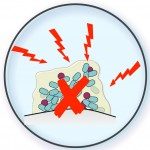Lien vers Pubmed [PMID] – 23733462
Antimicrob. Agents Chemother. 2013 Aug;57(8):3960-8
Antivirulence strategies targeting bacterial behavior, such as adhesion and biofilm formation, are expected to exert low selective pressure and have been proposed as alternatives to biocidal antibiotic treatments to avoid the rapid occurrence of bacterial resistance. Here, we tested this hypothesis using group 2 capsule polysaccharide (G2cps), a polysaccharidic molecule previously shown to impair bacterium-surface interactions, and we investigated the nature of bacterial resistance to a nonbiocidal antibiofilm strategy. We screened an Escherichia coli mutant library for an increased ability to form biofilm in the presence of G2cps, and we identified several mutants displaying partial but not total resistance to this antibiofilm polysaccharide. Our genetic analysis showed that partial resistance to G2cps results from multiple unrelated mutations leading to modifications in surface physicochemical properties that counteract the changes in ionic charge and Lewis base properties induced by G2cps. Moreover, some of the identified mutants harboring improved biofilm formation in the presence of G2cps were also partially resistant to other antibiofilm molecules. This study therefore shows that alterations of bacterial surface properties mediate only partial resistance to G2cps. It also experimentally validates the potential value of nonbiocidal antibiofilm strategies, since full resistance to antibiofilm compounds is rare and potentially unlikely to arise in clinical settings.






